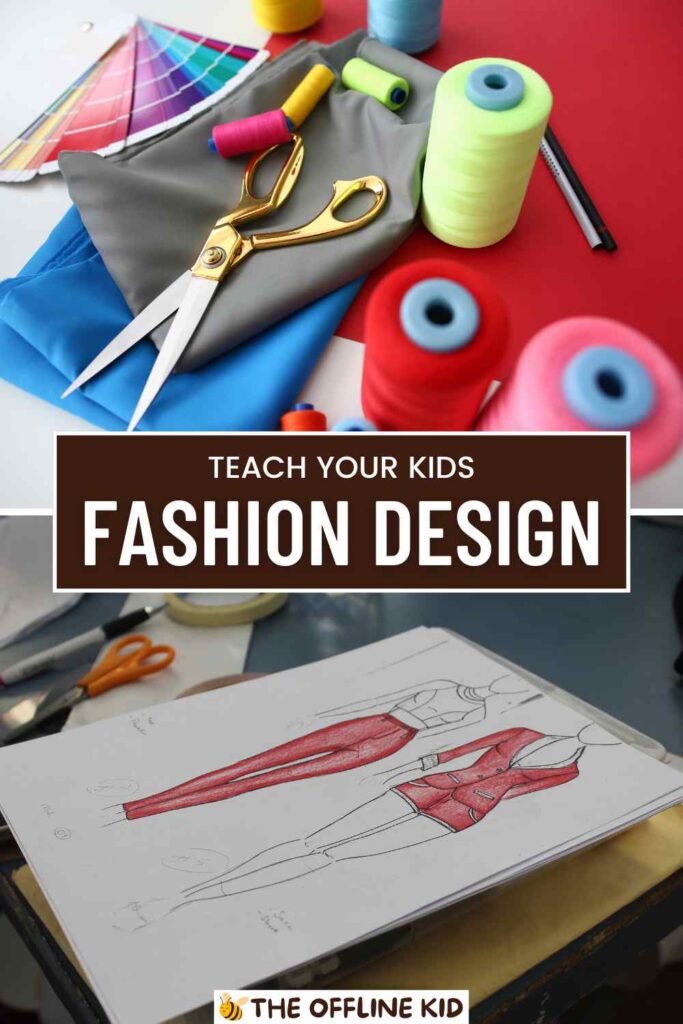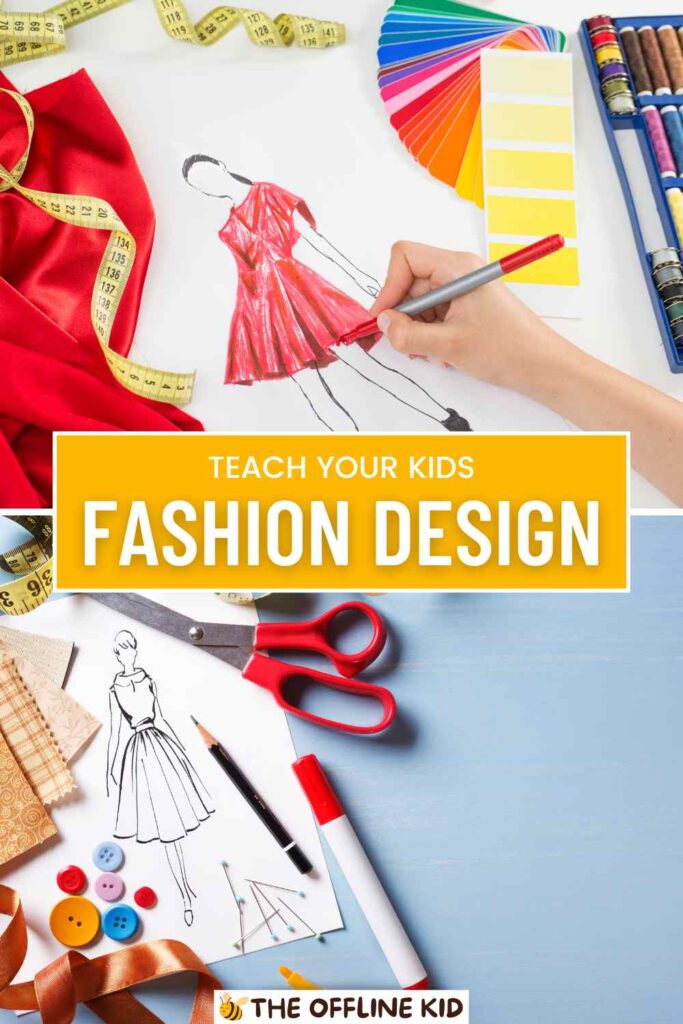Fashion can be a delightful playground of colors, shapes, and textures for children. Encouraging them to explore design fosters creativity, self-expression, and confidence.
This guide will help you introduce fashion design to your kid in a fun, engaging way, ensuring they thrive in this vibrant world of style.
Understanding Your Child’s Interest in Fashion
Fashion is more than just clothing—it is a means of self-expression, creativity, and cultural identity.
Recognizing your child’s interest in fashion can help you nurture their artistic side and allow them to develop essential skills that extend beyond dressing up.
By paying attention to small clues and consistent preferences, you can spark meaningful conversations about why certain styles, colors, or patterns appeal to them.
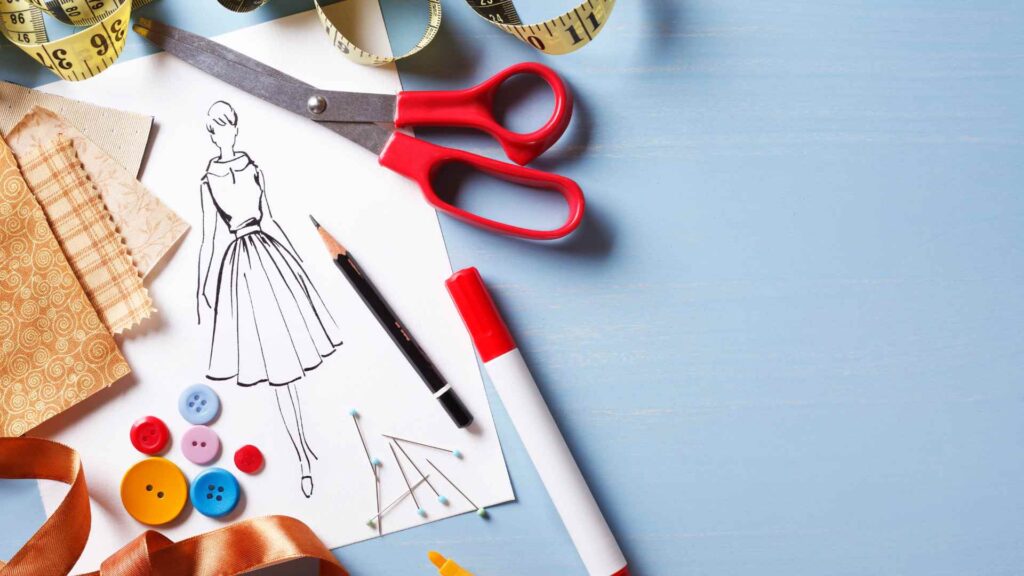
Spotting Early Signs
- Your child might love to play dress-up and experiment with old clothes around the house.
- They may show fascination with textures, running their fingers over different fabrics or commenting on how soft or sparkly they feel.
- They frequently draw people with detailed outfits in their artwork, paying close attention to sleeves, collars, and accessories.
- They enjoy color coordination, expressing strong preferences when helping you pick out their own outfits or even yours.
Importance of Communication
- Engage in daily chats about what they like or dislike in their clothes.
- Ask questions such as “What do you love about this outfit?” or “Which part of this design do you find exciting?”
- Encourage them to articulate their style and support their evolving taste.
Cultural and Personal Influences
- Explain how fashion differs across cultures, climates, and individual preferences.
- Demonstrate how personal experiences shape design choices, from a favorite holiday color scheme to a beloved cartoon character’s outfit.
- Encourage your child to explore these influences in mood boards, where they collect images, swatches, or ideas that inspire them.
Fostering Self-Discovery
- Give them the freedom to express themselves through clothes in a fun, non-judgmental environment.
- Show genuine enthusiasm for their choices, and highlight the uniqueness of their creations.
- This early confidence forms a solid foundation for diving deeper into the vast world of fashion design.
By understanding your child’s interest and nurturing it with curiosity, you lay the groundwork for a fulfilling and endlessly creative journey.
This initial awareness paves the way for deeper exploration of basic fashion concepts and encourages open-minded experimentation. When children realize they have a voice in fashion, they become excited to learn new techniques and ideas.
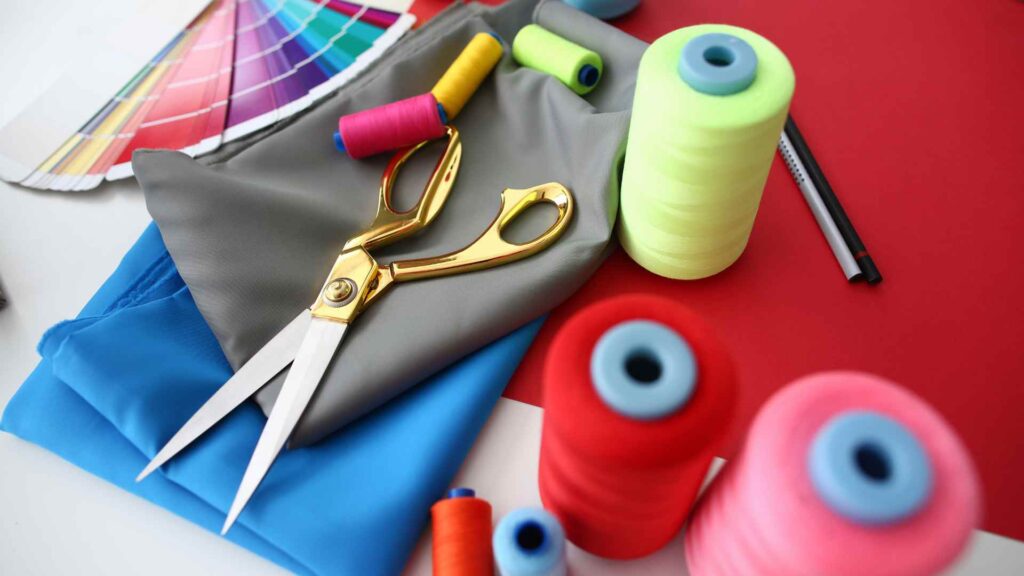
Exploring Basic Fashion Concepts
Once your child’s interest is evident, it’s time to introduce them to the fundamental building blocks of fashion.
Understanding color theory, silhouettes, patterns, and textiles will empower your child to make informed decisions when crafting designs. By breaking down these basics, you equip them with a strong design vocabulary.
Color Theory
- Primary, Secondary, and Tertiary Colors: Introduce how primary colors (red, yellow, blue) blend to form secondary colors (orange, green, purple). Then connect tertiary colors to show endless possibilities.
- Warm vs. Cool Tones: Explain how some colors evoke warmth (reds, oranges, yellows) while others feel cooler (blues, greens, purples).
- Complementary and Analogous Palettes: Let them experiment with color wheels and discover which pairings stand out and which create a harmonious effect.
- Hands-On Tip: Have them paint or use colored pencils to create mini “color explorations,” combining shades that spark their imagination.
Silhouettes and Shapes
- Basic Garment Styles: Demonstrate simple shapes like A-line skirts, shift dresses, and straight-leg pants.
- Proportions and Balance: Show them how length, width, and fit can alter the look of an outfit. For instance, pairing a loose top with fitted bottoms creates a balanced silhouette.
- Exaggeration: Kids love to play with oversized sleeves, big collars, or balloon pants—let them see how going big in one area can create a dramatic statement.
Patterns and Prints
- Stripes, Polka Dots, and Florals: Introduce timeless patterns that can transform any garment. Encourage them to doodle their own variations.
- Mixing Prints: Let them experiment with mixing polka dots and plaid, or stripes and florals. Discuss how combining patterns can create bold or chaotic impressions, depending on color balance.
- Pattern Play Exercise: Have them design patterns on paper squares and then tape them together to see how different designs connect or clash.
Textiles and Fabrics
- Cotton, Denim, and Silk: Introduce common fabrics and their characteristics. For instance, cotton breathes well, while denim is sturdy.
- Texture Exploration: Encourage them to compare soft materials like velvet with crisp fabrics like taffeta, discovering how each can affect a garment’s look.
- Upcycling and Sustainability: Explain how older garments or leftover materials can be given new life, fostering a sense of environmental awareness.
By exploring these basic fashion concepts, your child develops a solid foundation of design knowledge.
Equip them with fun activities—like mini color wheels or fabric scrapbooks—and create an environment where they feel free to make bold mistakes.
Through consistent practice, they’ll hone an intuitive design sense, getting ready to tackle more adventurous creative pursuits.
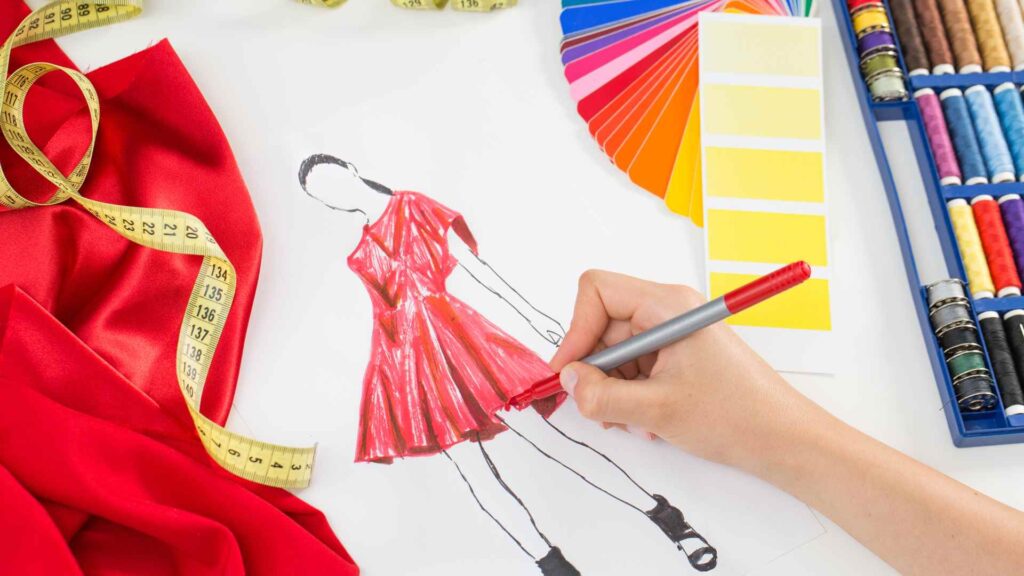
Encouraging Creativity and Self-Expression
When children delve into fashion design, they are essentially telling a story about who they are and who they want to be.
Encouraging creativity and self-expression can help them feel confident in their identity and capable of thinking outside the box. Fashion becomes a canvas for exploration, allowing your child to translate thoughts and feelings into visual form.
Open-Ended Projects
- Let them create without strict guidelines, prompting imaginative designs.
- Offer simple supplies—fabric scraps, beads, ribbons, and markers—and watch how they assemble their unique visions.
- Focus on the process instead of perfection, nurturing an “anything goes” atmosphere.
Mood Boards and Vision Boards
- Encourage kids to compile images, sketches, and swatches that represent their style inspirations.
- Let them describe their boards, explaining why certain images spark excitement.
- Mood boards act as a personalized inspiration map, guiding them through future projects.
Theme-Based Challenges
- Select a fun theme—like “under the sea,” “outer space,” or “jungle adventure”—and invite your child to design outfits that capture the theme’s spirit.
- Incorporate storytelling: Encourage them to imagine a scenario or character wearing the clothes they design.
- This playful approach makes the learning process engaging and helps them link design ideas with a captivating narrative.
Empower with Choice
- Involve them in decisions, from selecting which craft materials to use to determining how to style a finished garment.
- Emphasize the importance of originality. If their design doesn’t resemble current trends, celebrate it!
- Reinforce that fashion is personal, and each artist’s unique perspective deserves to be heard.
Artistic Collaboration
- If they have siblings or friends, organize small group projects that encourage sharing ideas and combining artistic visions.
- This collaboration not only fosters teamwork but helps them appreciate different design aesthetics.
- Encourage them to offer supportive feedback, building a warm creative community.
By championing your child’s personal style and celebrating every imaginative leap, you’re shaping a safe space for exploration. From layering bright colors to incorporating unusual themes, encourage them to take risks. The ultimate goal is for them to develop a fearless creative spirit—one that will serve them on the runway, in classrooms, and beyond.
Practical Skills and Hands-On Projects
As your child becomes comfortable with the basics and begins developing their own design voice, it’s time to introduce practical skills.
Teaching them simple sewing, sketching, and crafting techniques brings fashion ideas to life. By working on hands-on projects, they can appreciate the steps involved in translating a concept into a wearable piece.
Sewing Basics
- Hand-Stitching: Start with simple stitches like the running stitch or backstitch. Provide a needle, thread, and a piece of fabric for them to practice on.
- Sewing Machine Introduction: If they are mature enough, guide them in using a sewing machine under close supervision. Show them how to thread the bobbin, choose stitches, and sew straight lines.
- Repair and Alterations: Teach them how to fix small rips or adjust the length of a hem. This skill builds awareness about garment longevity and sustainability.
Sketching and Fashion Illustration
- Body Proportions: Introduce a basic fashion figure template (croquis) so they can focus on outfit design without stressing about perfect proportions.
- Pencil Techniques: Experiment with shading and highlights to depict different textures (e.g., ruffles, velvet).
- Color Rendering: Once they master pencil sketches, let them use colored pencils, markers, or watercolors to bring their designs to life.
Embroidery and Embellishments
- Hand Embroidery: Simple stitches like the satin stitch or chain stitch can decorate pockets, collars, and hems.
- Embellishing with Beads and Sequins: Show them how to sew on small beads, sequins, or patches to add flair to a garment or accessory.
- Upcycled Fashion: Transform an old T-shirt into a stylish, one-of-a-kind top by cutting fringes, tying knots, or adding embroidered motifs.
DIY Accessories
- Hair Bows and Headbands: Encourage them to choose ribbons, laces, or scrap fabrics and decorate with buttons or small flowers.
- Bracelets, Necklaces, and Brooches: Use beads, charms, and wires to create wearable art.
- Tote Bags: A simple canvas bag can be painted, embroidered, or embellished with fabric markers, letting them make a bold statement.
Project-Based Learning
- Mini Runway Show: After creating a few pieces, set up a mini fashion show at home where they can showcase their work.
- Photo Shoot: Snap pictures of them modeling their designs. This fun activity helps them appreciate the presentation aspect of fashion.
- Critique and Celebrate: Encourage positive and constructive feedback from family and friends, highlighting what worked well and what can be improved.
Practical skills and hands-on projects bridge the gap between a child’s imagination and tangible results. By empowering them with these newfound abilities, your child can begin confidently expressing their personality through clothes and accessories.
This tactile approach not only refines fine motor skills but also underscores the value of dedication and patience in creative pursuits.
Building Confidence and Presentation Skills
Fashion design is not just about creating clothing—it’s also about how those creations are presented to the world.
Teaching your child confidence and presentation skills is an essential part of introducing them to fashion.
When kids learn to showcase their ideas, stand proud in their designs, and communicate their fashion vision, they’re developing interpersonal skills and self-assurance that will help them in all areas of life.
Body Positivity and Self-Acceptance
- Reinforce that every body type, shape, and size is beautiful.
- Encourage them to design for themselves in ways that make them feel comfortable and true to their identity.
- Celebrate diversity in style and culture, showing examples of famous designers and models who embraced individuality.
Public Speaking and Explanation
- Encourage your child to talk through their design process, explaining color choices, silhouettes, and inspirations.
- Practice short presentations at home, perhaps after completing a new sketch or sewing project.
- Family Feedback: Allow relatives or close friends to ask questions, so your child learns to articulate creative decisions.
Mini Fashion Shows and Lookbooks
- Organize small-scale “fashion shows” at home or in a community setting. This builds performance confidence in front of an audience.
- Photography and Lookbooks: Help your child create a small photo album or digital slideshow showcasing their designs and the inspirations behind them.
- Brainstorm different poses and angles that highlight the garment’s features, encouraging them to feel natural and proud in front of the camera.
Positive Mindset and Resilience
- Remind them that not every design will work out perfectly—that’s part of the creative journey.
- Encourage an attitude of experimentation and adaptation, praising them for trying new ideas.
- Teach them to respond to constructive criticism positively: “How can I use this feedback to improve my next design?”
Celebrating Progress
- Regularly reflect on how far they’ve come, from their earliest color scribbles to their more advanced sketches and garments.
- Keep a portfolio or digital record of designs, sketches, and final pieces, allowing them to see their growth over time.
- Reward Effort: Applaud them for dedication and persistence, not just final outcomes.
By weaving confidence and presentation skills into your child’s fashion education, you help them cultivate poise, creativity, and self-worth.
These strengths extend well beyond the runway, supporting them in future endeavors such as public speaking, job interviews, or collaborative projects. Ultimately, the more confident your child feels in presenting their designs, the more they’ll enjoy the art of fashion as a whole.
Incorporating Technology and Online Resources
In today’s connected world, technology offers a wealth of innovative tools and interactive platforms to enhance your child’s journey into fashion design.
By blending traditional crafting with digital tools, your child can explore modern design methods, stay current with trends, and discover an ever-expanding universe of inspiration.
Digital Design Tools
- Fashion Design Apps: Platforms like Sketchbook, Adobe Fresco, or Procreate allow kids to experiment with digital brushes, colors, and textures.
- Virtual Clothing Platforms: Some websites let children create avatars and design outfits virtually. This not only fosters creativity but also develops computer skills.
- Online Pattern Making: Older kids might enjoy exploring sites that generate custom pattern templates for sewing, offering a real-world product of their digital creation.
Online Tutorials and Workshops
- YouTube Channels: Many fashion educators share step-by-step tutorials on sewing, styling, and embellishments. Select channels that focus on children-friendly content with safe language and easy instructions.
- Live Webinars: Check if local designers or fashion schools offer free or low-cost webinars tailored to beginners.
- Interactive Communities: Encourage your child to join forums or social media groups where young designers share tips and cheer each other on.
Fashion History and Trend Research
- Historical Costume Museums: Explore virtual tours of museums like the Metropolitan Museum of Art’s Costume Institute or the Victoria & Albert Museum to learn about fashion evolution.
- Trend Platforms: Allow them to browse kid-friendly versions of trend sites or curated blogs to see what’s happening in global fashion.
- Research Assignments: Encourage your child to compare different eras—such as the flamboyant 1980s vs. the minimalist 1990s—to understand how cultural shifts influence style.
Responsible Media Use
- Monitor screen time to ensure a healthy balance of online and offline creative activities.
- Teach them to verify the authenticity of sources when researching.
- Discuss digital etiquette—like giving proper credit when using someone else’s designs or referencing their work.
Project Ideas with Technology
- Digital Sketch Portfolio: Have your child compile their digital sketches in a slideshow or PDF, highlighting design notes and inspirations.
- Video Tutorials: If they feel comfortable, encourage them to film short clips explaining their creative process and share them with friends or family.
- Online Fashion Challenges: Many websites and social media platforms host contests or challenges where participants design an outfit around a theme. This can spark ideas and help kids connect with peers globally.
By integrating technology into your child’s creative journey, you open the door to boundary-pushing innovation and new avenues for self-expression. This fusion of classic hands-on techniques and cutting-edge digital tools can ignite a lifelong passion for fashion, while also helping your child become a confident digital citizen.
Collaborative Projects and Showcasing Achievements
Collaboration can turn the solitary nature of designing into a social, community-driven adventure.
Whether your child works with siblings, friends, or local groups, participating in shared fashion projects helps them learn teamwork, appreciate diverse perspectives, and discover new creative possibilities. Showcasing achievements along the way fosters pride and motivation.
Group Design Brainstorm
- Encourage them to team up on projects, dividing tasks like sketching, sewing, or embellishing.
- Teach them to combine different aesthetics into a cohesive collection, much like a real design house.
- Emphasize communication: Let them talk through ideas, compromise on certain elements, and celebrate each member’s unique contributions.
Community Engagement
- Connect with local community centers or after-school clubs that offer design workshops.
- Volunteer opportunities: Consider collaborating on sewing projects for charity, such as creating blankets or simple garments for those in need.
- Participating in community events helps your child realize that fashion design can be an impactful force for good.
School Fairs and Competitions
- Encourage your child to showcase their work during school art fairs or local youth festivals.
- Joining competitions with themes—like recycled fashion—can push them to explore new techniques.
- Even if they don’t win a prize, the experience helps them learn from others, gather feedback, and grow.
Organizing a Family “Fashion Week”
- Dedicate a weekend for a family-run fashion event at home.
- Help your child arrange a mini runway, complete with music and lighting.
- Invite neighbors or friends to view the designs, turning it into a festive celebration of art and creativity.
Building a Portfolio
- Encourage your child to keep a record of each collaborative project: sketches, fabric swatches, photos, and notes on the process.
- Over time, they can build a robust portfolio or scrapbook that documents their growth as a designer.
- This practice not only boosts self-esteem but also helps them reflect on past successes and ideas for improvement.
Celebrating Milestones
- Each completed collection or collaborative piece is worth celebrating, whether it’s a small home party or a simple family toast.
- Compliment them on specific details—like the color palette, neat stitching, or creative design elements.
- Positive reinforcements keep them energized and eager for more collaborations.
When children engage in group ventures and publicly display their hard work, they experience the thrill of shared accomplishment.
This social dimension of fashion design teaches them valuable lessons about cooperation, communication, and empathy. Showcasing achievements—no matter how big or small—nurtures a sense of pride and a continued eagerness to create.
